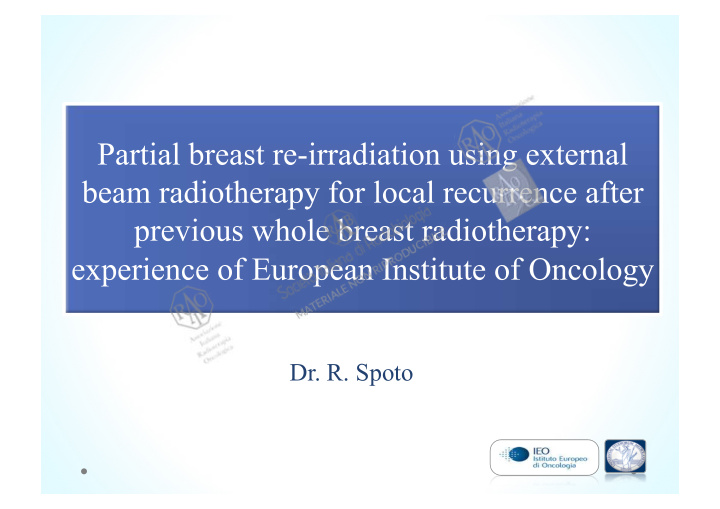



Dr. R. Spoto
2016
• locoregional tumor recurrence after WBRT (pT ≤ 2; pN ≤ 1) • Unifocal disease • Patient preference • Second breast conservation is technically feasible
• BrainLab VERO: step-and-shoot IMRT • Tomotherapy: helical IMRT modality
• Dose deliverd: 37.05 Gy in 13 fractions (2.85 Gy/fr) • planning objectives: PTV: V100% ≥ 95%, V95% ≥ 98%, D0.03cc ≤ 110% CTV PTV 5 mm
STRUCTURE PLANNING MEDIAN RANGE OBJECTIVES PLANNED D max ≤ 110% 107% 103.7 – 111.7 V 100Gy ≥ 95% 82.3% 50 – 97.4 V 95Gy ≥ 98% 97% 87 – 100 V 90Gy ≥ 100% 99.5% 93.2 – 100 D mean Heart < 4Gy 0.7 Gy 0.18 – 4.1 left breast V 20Gy ipsi.lung < 10% 1.2 % 0.1 – 7.9 V 25% ipsi.breast < 35% 33.4% 3.7 – 52 V 100% ipsi.breast < 10% 0.7% 0.005 – 4.4 V 2,5% cont.Breast < 0.02% 0% 0 – 47
• Between 06/2012 and 11/2015 • Number of patients: 48 • Median age at recurrence: 60.7 y (range: 37.5-88.7) • Median time to recurrence: 137.3 m (range25.6-319) • Treated with VERO: 39 • Treated with TomoTherapy: 9
17 patients has recurrence in the SAME quadrant 31 patients has recurrence in DIFFERENT quadrant
Data available for all 48 patiens GRADE ERYTHEMA EPITHELIOLISIS EDEMA 0 52.1% 98% 91.7% 1 47.9% 2% 0 2 0 0 8.3% INTENSITY PAIN ITCH BURNING 0 89.5% 89.5% 93.8% 1-3 6.3% 10.5% 6.2% 4-7 4.2% 0 0 8-10 0 0 0
Median follow up: 22.1 m (range 0.5 – 48.8) • n° pts NED = 45 • n° pts AWD = 3 - All developed distant metastasis - Median time to II recurence: 12.1 m - Ki67 always >20% - Recurrence in the same quadrant NO in field recurrence
Data available for 15 patients Collateral effect Data IEO Letterature (EBRT) Collateral effect Data IEO Fibrosis (G2-G3) 26% 60% (G2-G3) Fibrosis (G2) 4 (26%) Dyschromia 13.3% 23-37.5% Dyschromia 2 (13.3%) All patients has G1 G2 toxicity Telangiectasia 13.3% 50% Telangiectasia 2 (13.3%) Pain 20% 12.5% Pain 3 (20%) Fibrosis G1 5 (33.3%) 1 patient has G3 retraction Oedema 2 (13.3) Retraction 9 (60%) Harkenrider 2011 Deutsch 2002
• Second breast conservative therapy represents a feasible alternative to mastectomy • This treatment is well tolerated • Longer follow-up is needed
“ I think if you do something and it turns out pretty good, then you should go do something else wonderful, not dwell on it for too long. Just figure out what’s next. ” Steve Jobs
Recommend
More recommend